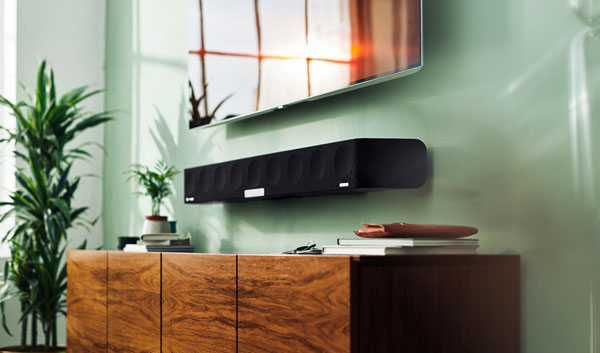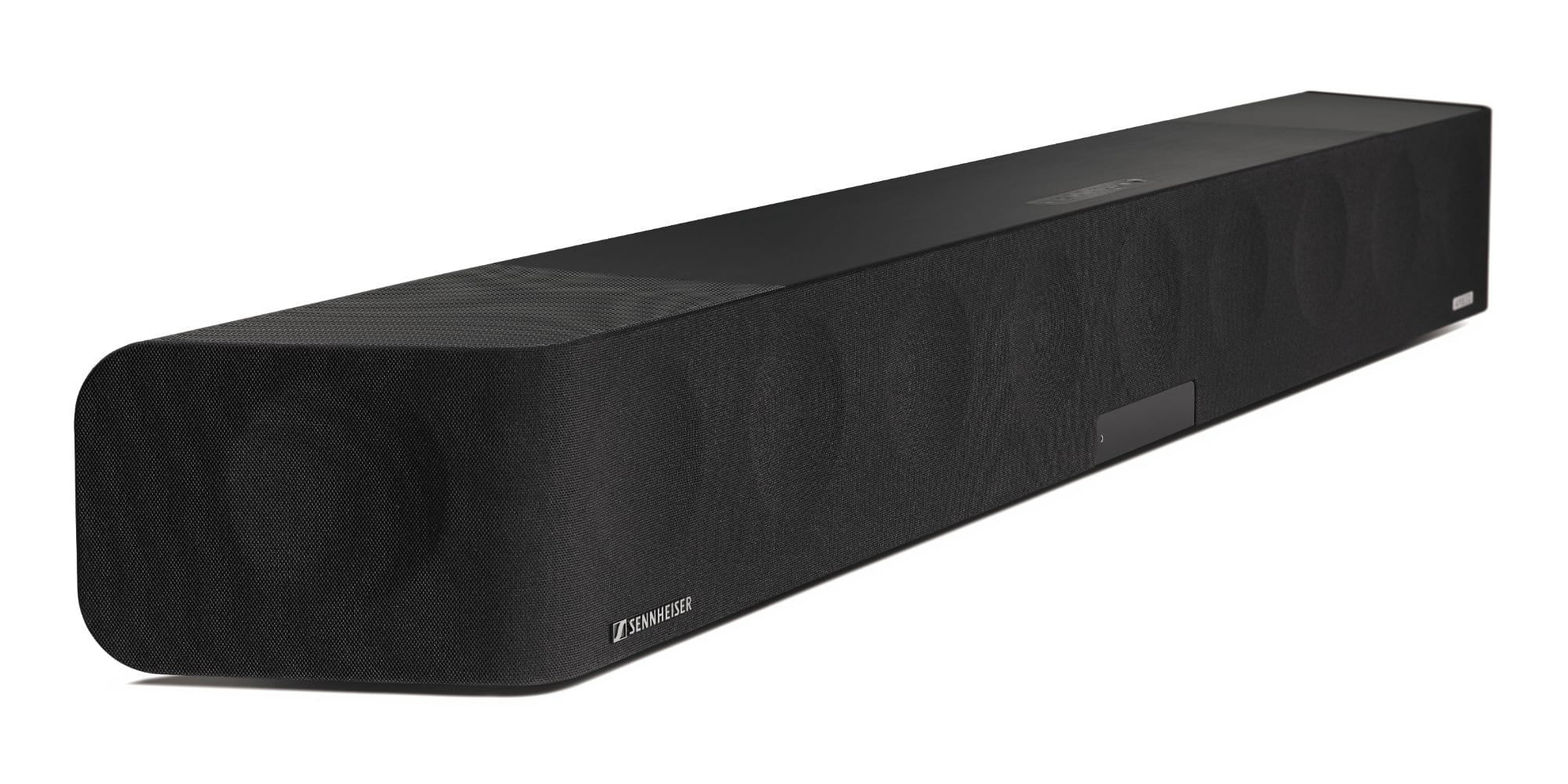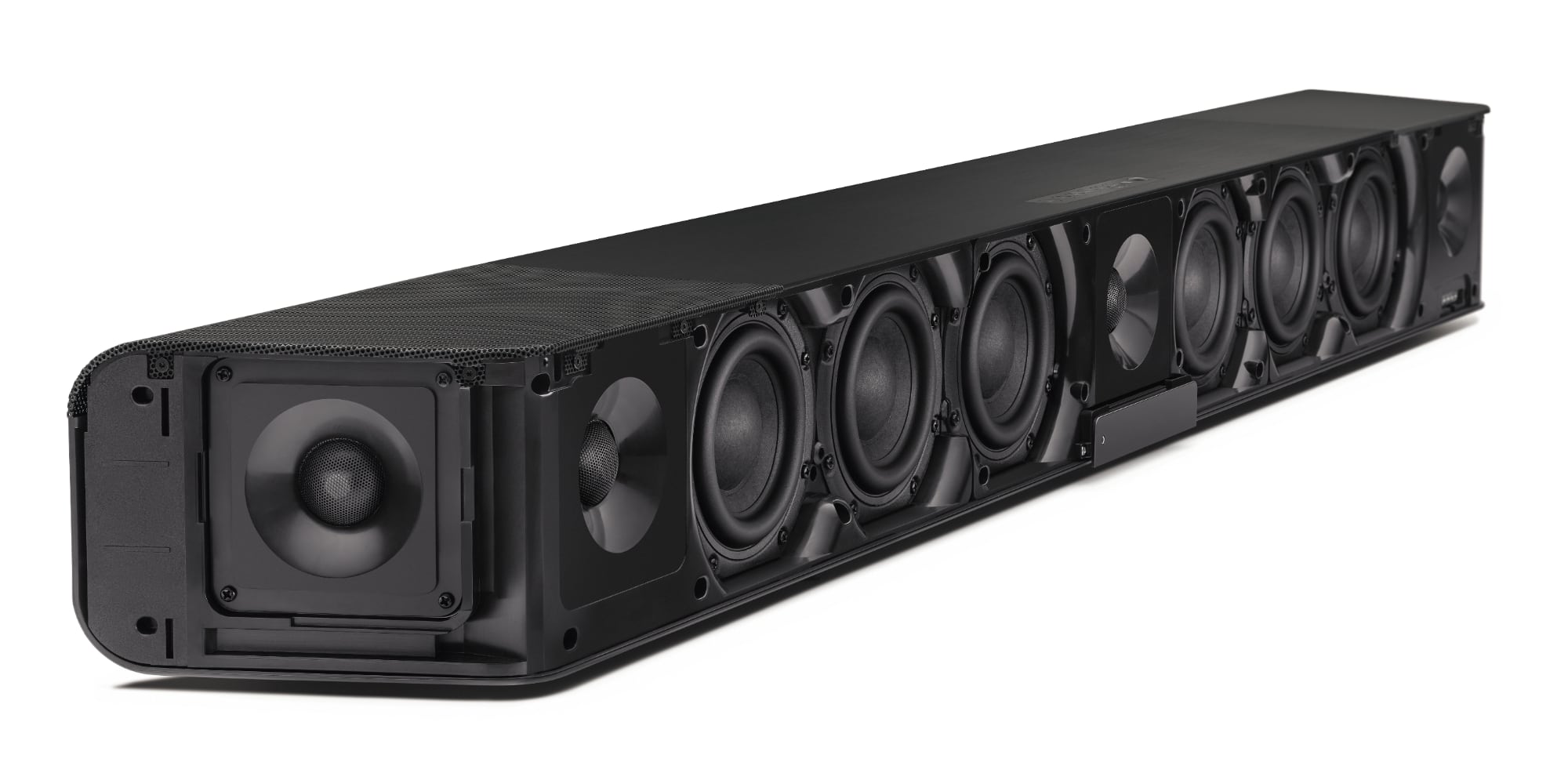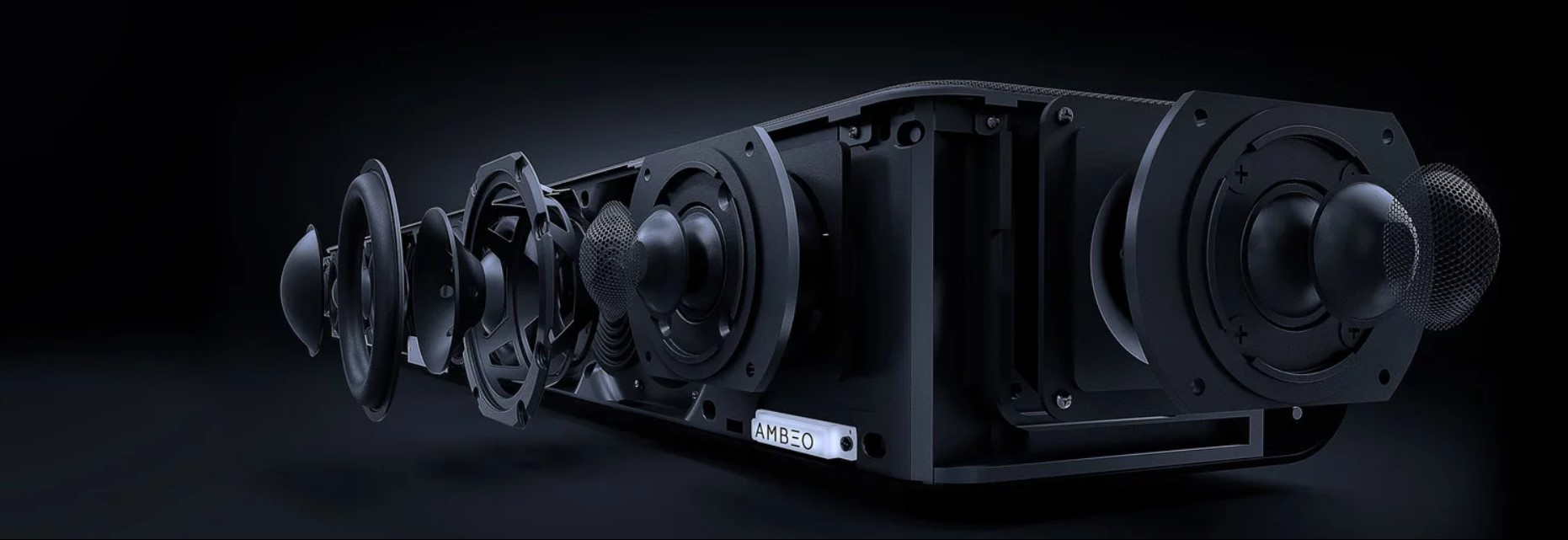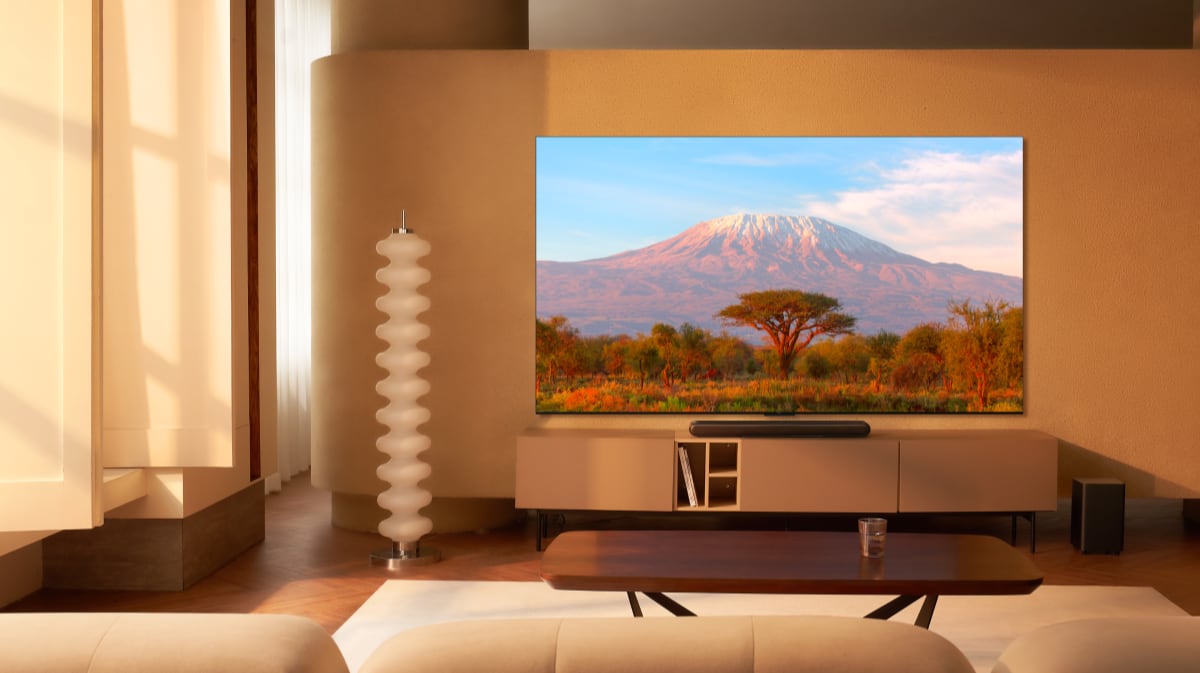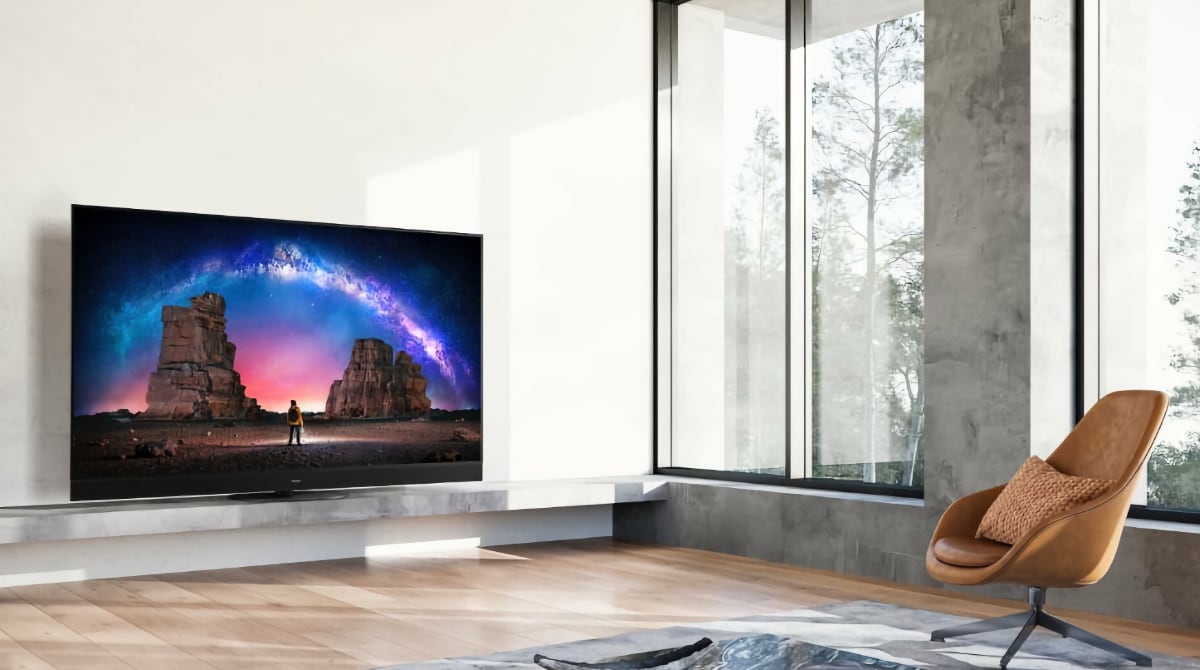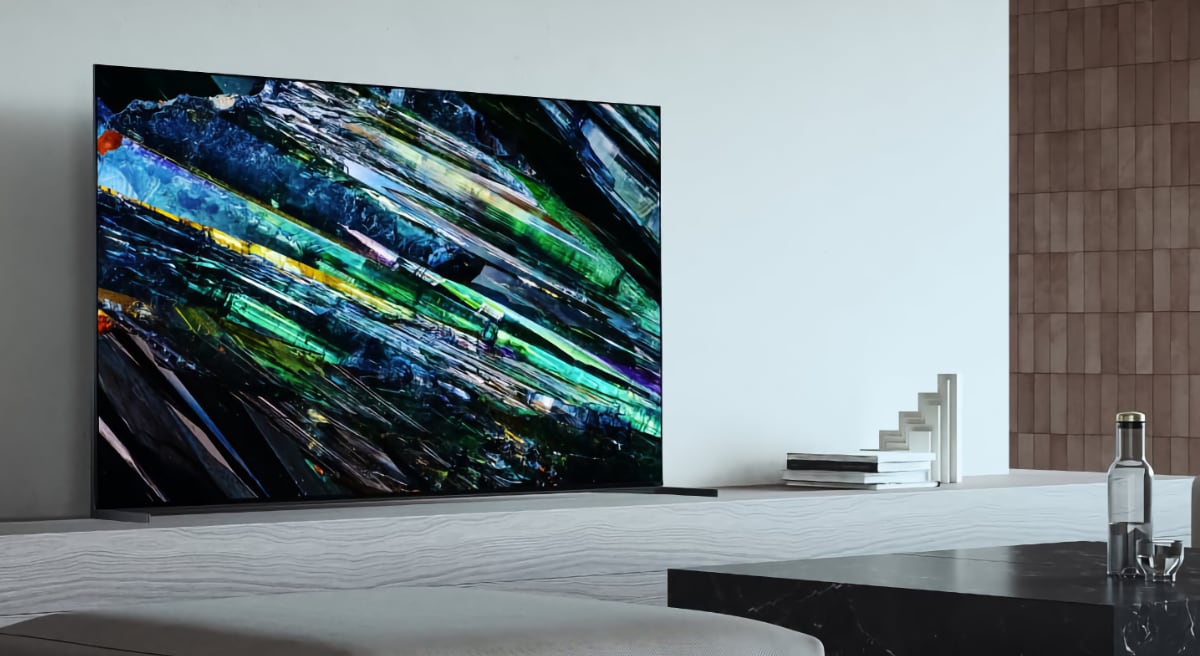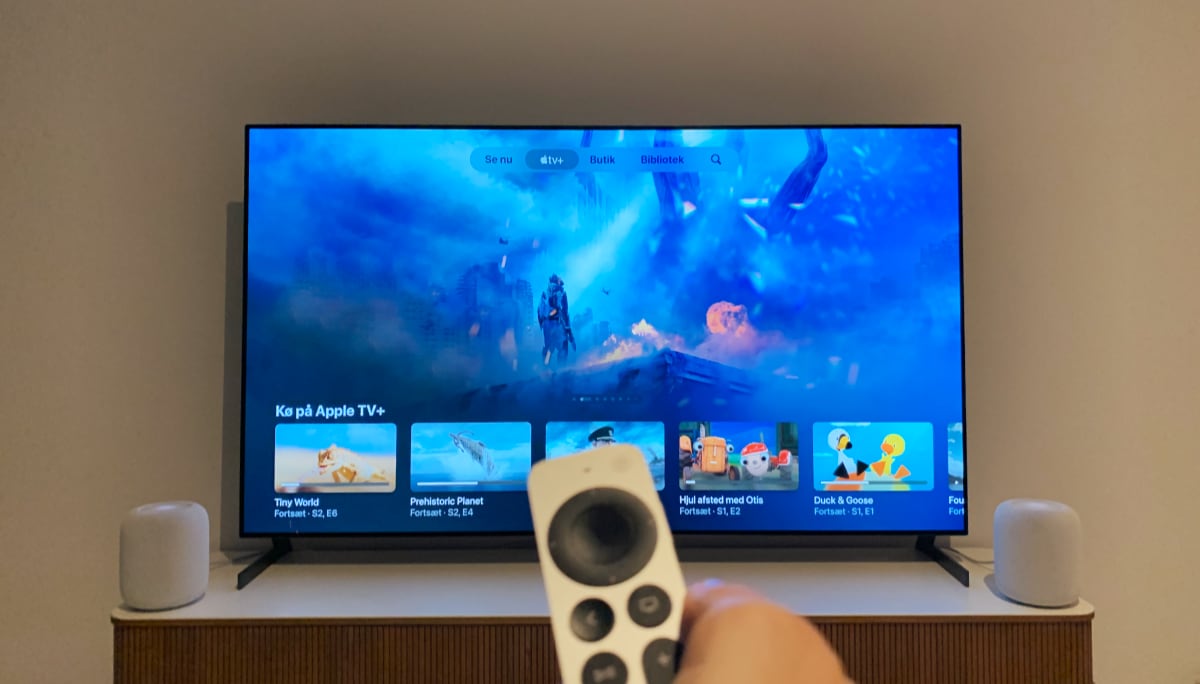Sennheiser has been teasing its Ambeo soundbar for what feels like years. It has finally arrived and the massive soundbar comes packed with a 5.1.4-channel system that supports Dolby Atmos, DTS:X and MPEG-H as well as Dolby Vision passthrough, enough bass to obviate the need for a subwoofer (according to Sennheiser), and 3 HDMI input ports.
Sennheiser's Ambeo soundbar can be yours for $2499 or €2499, making it one of the most expensive soundbars on the market. Let's find out if it delivers.
Price and retailers:
Sennheiser Ambeo – specifications
| |
|---|
| Design | Soundbar |
| - dimensions (HxWxD) | 126.5 x 12.5 x 17.1 cm (on feet) | | - weight | 18.5 kg | | - wall mounting | |
|
|
| Speakers | 5.1.4 channels (550W) |
| - tweeter | 5x 1" tweeter, aluminium dome tweeter | | - woofer | 6x 4" longthrow woofer | | - fullrange | 2x 3,5" fullrange driver (top-firing) | |
|
| Audio formats | Dolby, DTS, MPEG-H |
| - Dolby Atmos | | | - Dolby TrueHD | | | - Dolby Digital Plus | | | - Dolby Digital | | | - DTS:X | | | - DTS | | | - MPEG-H | | | - Hi-Res Audio | | |
|
|
|
| HDMI in/out | 2.0b |
| - HDMI inputs | 3 | | - HDMI ARC / eARC | / | | - passthrough 4K | | | - passthrough HDR10 | | | - passthrough Dolby Vision | | | - passthrough VRR | | | - passthrough QMS | | |
|
| Inputs | HDMI, Optical, Ethernet, L/R phono, LAN, USB (for updates), microphone port |
| Outputs | HDMI eARC, subwoofer |
|
|
| WiFi | (WiFi 5) |
| Wireless protocols | Yes |
| - Chromecast | | | - AirPlay 2 | | | - Bluetooth | |
|
|
| In the box | User manual, remote control, calibration microphone, HDMI cable |
First impressions
The market is overflowing with new soundbars claiming to deliver Dolby Atmos, and manufacturers are lining up to dilute the definition. Common to many of these soundbars is that they lack essential hardware components to deliver the great Atmos experience. Many of these manufacturers simply try to 'expand' the sound stage through sound processing mechanisms rather than focusing on adding additional speaker units to the mix.
Stepping up into the high-end segment of soundbars, you will often find systems than come equipped with up-firing units, sometimes rear speakers, and not least better speaker/driving hardware in general. These soundbars typically start from $1000-1500, depending on brand and time of year. Some come bundled with wireless subwoofers to help compensate for the slim cabinet of the soundbar. Until now, that is. Sennheiser's Ambeo soundbar was exhibited for the first time a few years ago and was launched officially earlier this year. When we experienced Ambeo back in 2017 it was clear to us that Sennheiser was creating Ambeo to stand out, both in potency and looks.
Ambeo is Sennheiser's marketing term for its end-to-end 3D audio solutions that cover more than just a soundbar. The Ambeo line-up also comprises microphones, headsets, car audio, software plugins, and guidelines for audio recording.
You will be hard pressed to find a soundbar that is aesthetically pleasing and Ambeo is certainly not taking home any prices for appearance. It is a massive soundbar and the all-black exterior does not exactly blend into a living room. Build quality on the other hand is exemplary, with fabric covering the front of the cabinet and metal on top. The wedge-shaped front serves the purpose of getting the units in position for side-firing audio. It weighs almost 20 kilograms, which is an early indication of its performance. It also sets it apart from much more affordable soundbars. Below you see Ambeo next to my Sonos Playbar, which looks almost like a pocket speaker in comparison.
Ambeo rests firmly on two rubber strips on its underbelly but the height of Ambeo will prevent users with a TV on a table stand from placing the soundbar directly underneath. As such you may be forced to wall mount your TV to make room for Ambeo underneath or find a different furniture solution. Of course, this is a consequence of fitting a soundbar with front-firing 4-inch bass units.
All connection ports are tucked away deep inside a notch at the bottom, and we recommend that you connect cables before you place the soundbar on furniture. It is not exactly easy to turn. We found 3x HDMI inputs, 1x HDMI eARC/ARC, optical audio, phono audio, a LAN port, and a USB port intended for firmware updates. Furthermore, this is an output for a subwoofer, if you want even more raw power. The HDMI inputs support Dolby Vision passthrough, ensuring that the soundbar is not the bottleneck in getting dynamic metadata for HDR video to your TV. 4K, HDR10, and Dolby Vision passthrough will allow you to loop through your playback devices such as UHD Blu-ray players.
The only visible port is the microphone input, which in my opinion is a shame since it disturbs the clean look. The same can be said about the big glowing Ambeo logo in the lower right. However, it is possible to reduce brightness from Sennheiser's Control smartphone app. In the middle there is a display that shows information about source or audio format. Likewise, you can adjust display brightness from the app.
Lastly, there are a few physical buttons on the top of the soundbar for adjusting volume, source, and the strength of the 'Ambeo effect'. On top you can also see the grille in front of the two full-tone, up-firing units. In the box we found an HDMI cable and the calibration microphone, which is an essential part of setting up Ambeo.

Set-up
As mentioned above, Ambeo comes bundled with a calibration microphone, which is one area in which it differs from many competing soundbars. It is possible to set up the system without using Sennheiser's app but if you want access to additional features and the option to update the firmware wirelessly, you should download the free 'Smart Control' app on your smartphone. The app did occasionally suffer from a connectivity issue where it refused to connect to Ambeo (via Bluetooth) but just keep trying and it will work eventually. I only used the app once for set-up as firmware updates can be carried out via the USB port so I do not consider this a major issue for users.
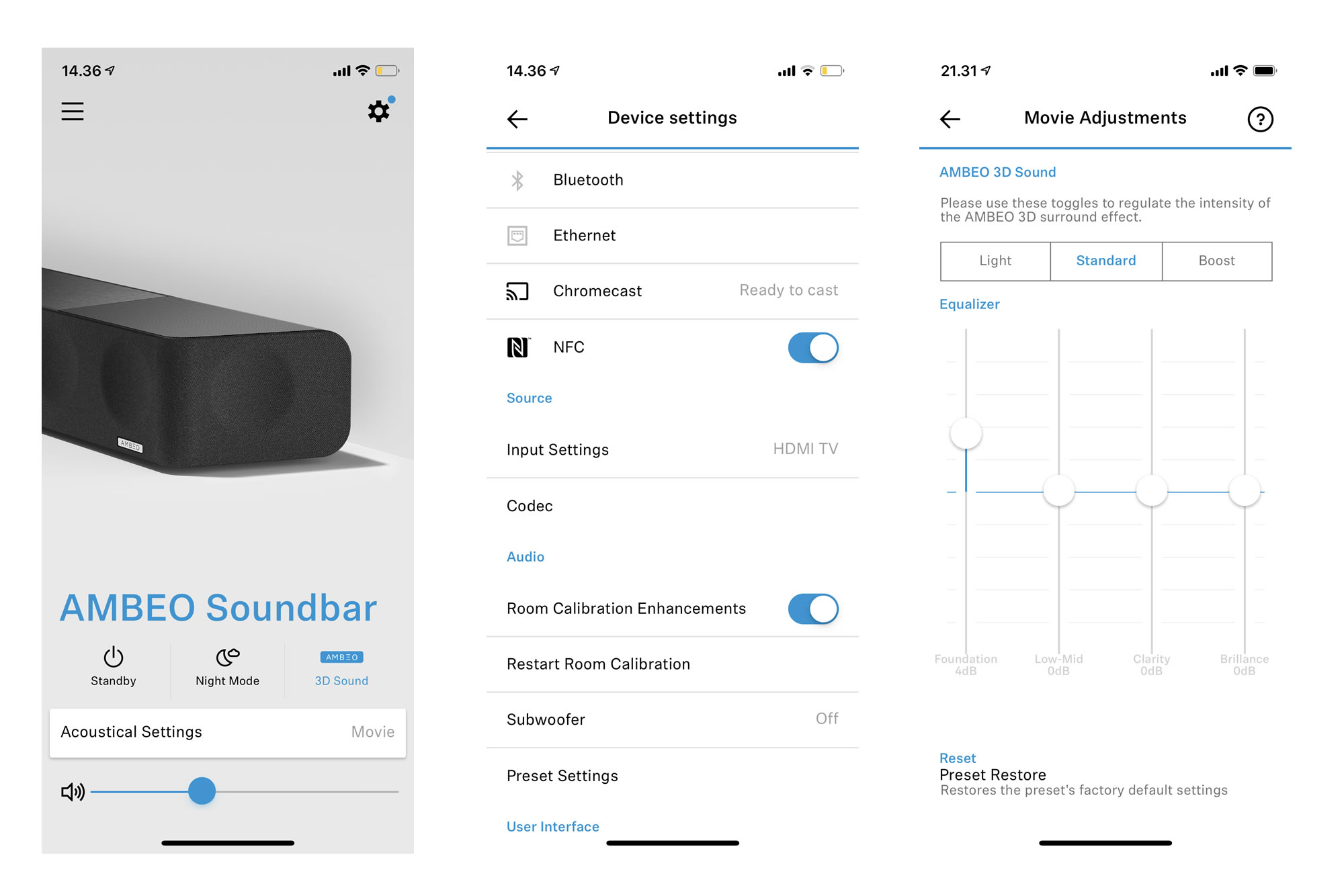
After I had unpacked and set up the soundbar, the display prompted me to connect the calibration microphone in order to carry out room calibration. The microphone is mounted on a stand approximately the same height as a typical seating/listening position in a living room, and you should place the microphone exactly in the spot where you would normally sit. The cable is very long so it should work as intended even in large living rooms. It is just a regular phono cable so you can easily find an even longer one, if necessary.
Room calibration works like this: The speaker outputs a series of sinus sweeps, logs sound from the various units inside, and then tries to filter out unwanted artefacts (reflections etc.) from the living environment through compensation. Of course, there are limits to how effective calibration through a signal processor can be, and Sennheiser notes that Ambeo only to some extent can compensate for a living room that is not perfectly square, or with an odd layout or seating position.
In my living room, Ambeo was placed further from one wall than the opposite wall, and we have our sofa pushed all the way up against the back wall, meaning that there is little free space behind it. This is probably a common scenario in homes. As such the calibration microphone was placed approximately a meter from the back wall as this corresponds to the seating/listening position. Sennheiser notes that for the optimal experience the distance to each wall should not exceed 5 meters as it will affect how sounds are reflected. This may pose a limitation in some living spaces and you should consider beforehand where to place your TV and Ambeo, if you want the optimal experience. It is of course worth emphasizing that a larger room will not necessarily kill the Atmos side-firing effects from Ambeo. It will just affect them negatively.
Besides the app, basic features can be controlled with the bundled remote control. The remote has a good weight to it and is made from decent plastic quality but it is a little too directional. It has buttons to switch between the different sound presets. The two most useful presets are probably 'Music' and 'Movie', if you are planning to use Ambeo for both TV entertainment and music via the same source. Ambeo does not have a graphical user interface so all commands trigger response only from the small front-facing display. In addition, you can control audio volume with your TV's remote control, if Ambeo is connected via HDMI ARC/CEC.
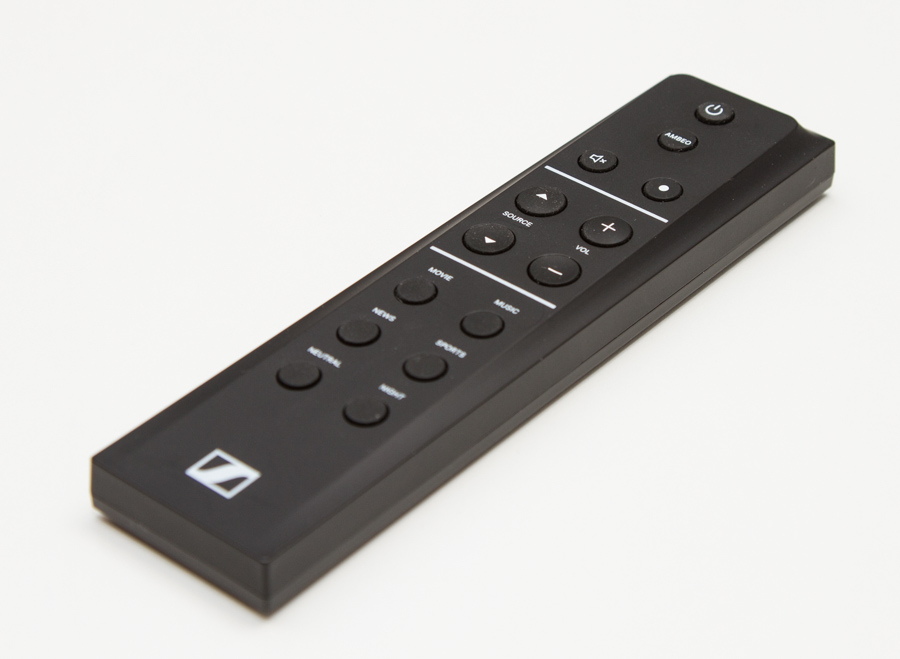
You should connect the soundbar to your TV via HDMI ARC/eARC. The capabilities will depend on whether your TV supports standard ARC or 'enhanced ARC' (eARC). The latter enables lossless Dolby Atmos (in Dolby TrueHD) and lossless DTS:X, whereas standard ARC is limited to lossy formats such as Dolby Atmos inside a Dolby Digital Plus container. Unfortunately, we were not able to get a Sony A9F/AF9 TV to play nice with Ambeo and output Atmos via eARC so we ended up connecting all devices directly to the HDMI switch in the soundbar. You can obviously use the optical or analog ports to connect the soundbar to your TV but the former will be limited to Dolby Digital 5.1 and the latter to stereo, both defeating the purpose of Ambeo. I highly recommend that you use the HDMI ARC port!
A couple of times during the review period, we experienced the usual HDMI CEC issues where some devices failed to turn off together with the rest. Other than that the HDMI switch works as intended and passthrough of Dolby Vision did not cause any problems for us. One could argue that the switch is an advantage only if you have playback devices that support Atmos. There is nothing to prevent you connecting some HDMI inputs to the TV and others to the soundbar.
For our review, we used an Apple TV 4K and a Sony UDP-X800 UHD Blu-ray player connected to Ambeo. As mentioned, we also tried to connect the soundbar via HDMI eARC to a Sony A9F/AF9 TV that had a PlayStation 4 connected (PS4 does not support Atmos).
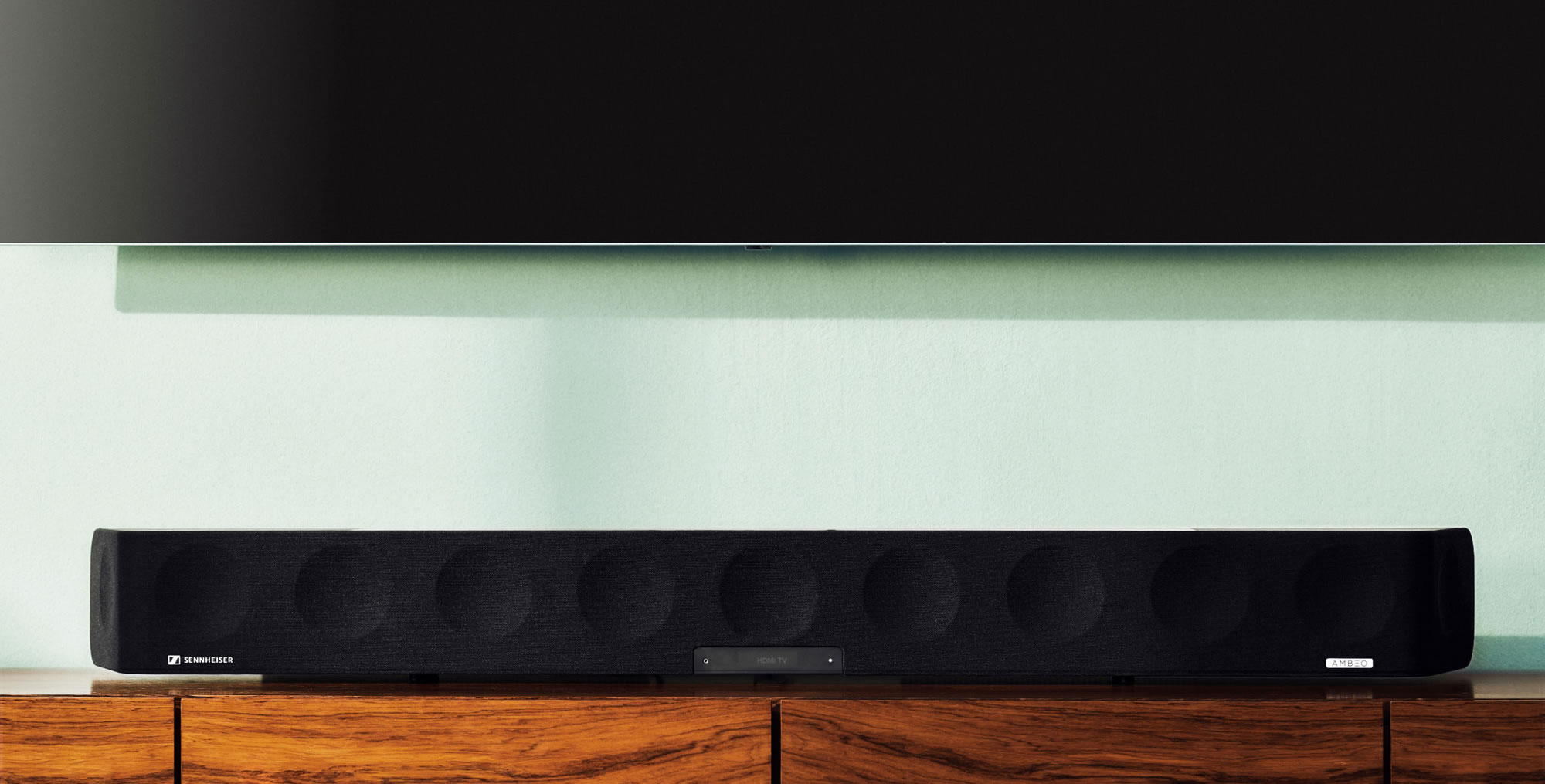
Sound: Movies & TV
Sennheiser Ambeo is first and foremost a soundbar designed for movies, so the most important factor is how it performs in this category. The Atmos experience will vary considerably from one movie to another so to test its Atmos capabilities in isolation we used Dolby's own test disc that contains various clips designed specifically for the purpose, along with some movie scenes with well-implemented Atmos.
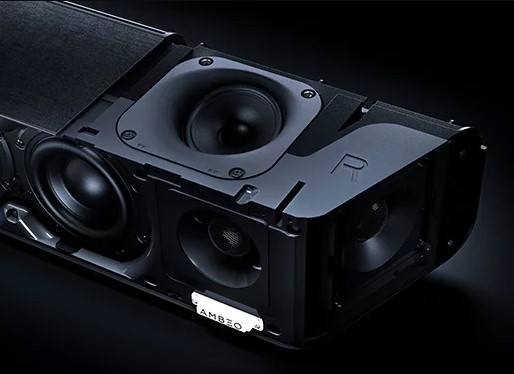
The disc is good for demonstrating the differences between conventional (Dolby) surround sound and Dolby Atmos since it has sequences where you can flip between audio formats during playback. If a given soundbar or sound system fails to deliver an ascertainable difference here, it is unlikely that it will deliver a great Atmos movie experience. Luckily, Ambeo clearly demonstrates how Atmos can significantly expand the sound stage. On the other hand it is also evident from the start that it struggles to handle rear sound.
There is a very good sense of 'movement' in the sound stage directly in front of you, and you often sense that you can reach out and grab an object slightly above your face. But you never get the sense that anything is moving around behind you. With speaker systems like Ambeo that use walls and ceiling to bounce, or reflect, sounds, the experience will depend on the layout of the room so you may be getting different results. However, we have on several occasions listening to Ambeo in a perfectly square and optimized listening room with reflectors on the walls, and the experience was more or less the same, meaning that Ambeo fails to deliver rear sound - despite the couch having been pushed forward to allow for more free room behind the viewer.
Turning our attention to movies, there is a decent selection of Dolby Atmos titles available on the market. If you are onboard the Apple bandwagon iTunes - or the Apple TV app - on Apple TV 4K offers many Atmos-enabled titles for rent or purchase (
full list here), most of which are also in Dolby Vision HDR. Of course, this is not lossless Atmos. At this time, all streaming services package Dolby Atmos in compressed Dolby Digital Plus. If you want lossless Atmos audio your only choice at this moment is Blu-ray but I think it is worth pointing out that since soundbars have obvious limitations many listeners should be perfectly happy with compressed Atmos. Below you will see a few shots of some of the movies from my collection but during the review I enjoyed more than 30 movies (with or without Atmos). Movies enjoyed through the Sony UHD Blu-ray player were obviously in lossless Atmos.
Let us start with
Blade Runner 2049, which has many cool scenes to demonstrate Atmos. Reverberation changes throughout the movie and the soundtrack contains ambient music that puts bass to the test. The casino scenes have a lot of spectacle, with sudden shifts between noise and rumbling to quiet dialogue, then back to reverberation in the casino theatre and loud explosions. Ambeo convincingly handled explosions mixed with shattering glass and gunshots, and treble did not take on a shrill tone, which is often the case with soundbars that employ only treble and woofer. If a movie calls for thunder, Ambeo brings thunder. It is impressive to behold how Ambeo delivers essentially the full audio spectrum from a single cabinet without an external subwoofer. As a sound solution for the living room it has, in my opinion, enough punch, bass, and power. I never found myself thinking that it lacks bass.
Next up is
Fantastic Beasts: The Crimes of Grindelwald. Its music / soundtrack fills the room. Its countless action sequences are a perfect fit for Atmos, too. At the same time, there is plenty of human dialogue. Ambeo delivers well-balanced and clear sound, while the music helps move the ambience out into the room. At times, sound effects approach the rear listening field but never in the same clear manner that discreet rear speakers can produce. I missed more movement in sound in the sense that even though sounds filled the room, they were not as dynamic as Atmos allows, and often as the magical creatives flew over my head sound objects lacked precision. It was more a sense of "a lot going on up there" - but too diffuse.
Rounding out the action genre, I invited
Venom into my living room. Once again, Ambeo fills the room with music and Venom's voice in the head of Eddie is a good example of the room-filling audio that Atmos is capable of. Again, I sometimes missed precision in overhead effects. You can clearly discern sounds in front of you and as a sound object such as a flying drone moves around, Ambeo manages to deliver clear movement of audio from 'up to down' or 'side to side' but never clearly defined as 'over your head or behind you'.
Overall, Ambeo creates a detailed and full sound stage in front of the listening experience but it lacks definition in sound objects above the listener and behind. The bass units deliver punch and the amplifiers are powerful enough to fill even a quite big living space. For typical soundbar use, adding an additional subwoofer seems unnecessary. I never yearned for extra noise and bass, partly because Ambeo has such good control over the bass. I would recommend that you use the 'Movie' mode for movies as the 'Normal' mode tends to sound a little flat for the purpose.
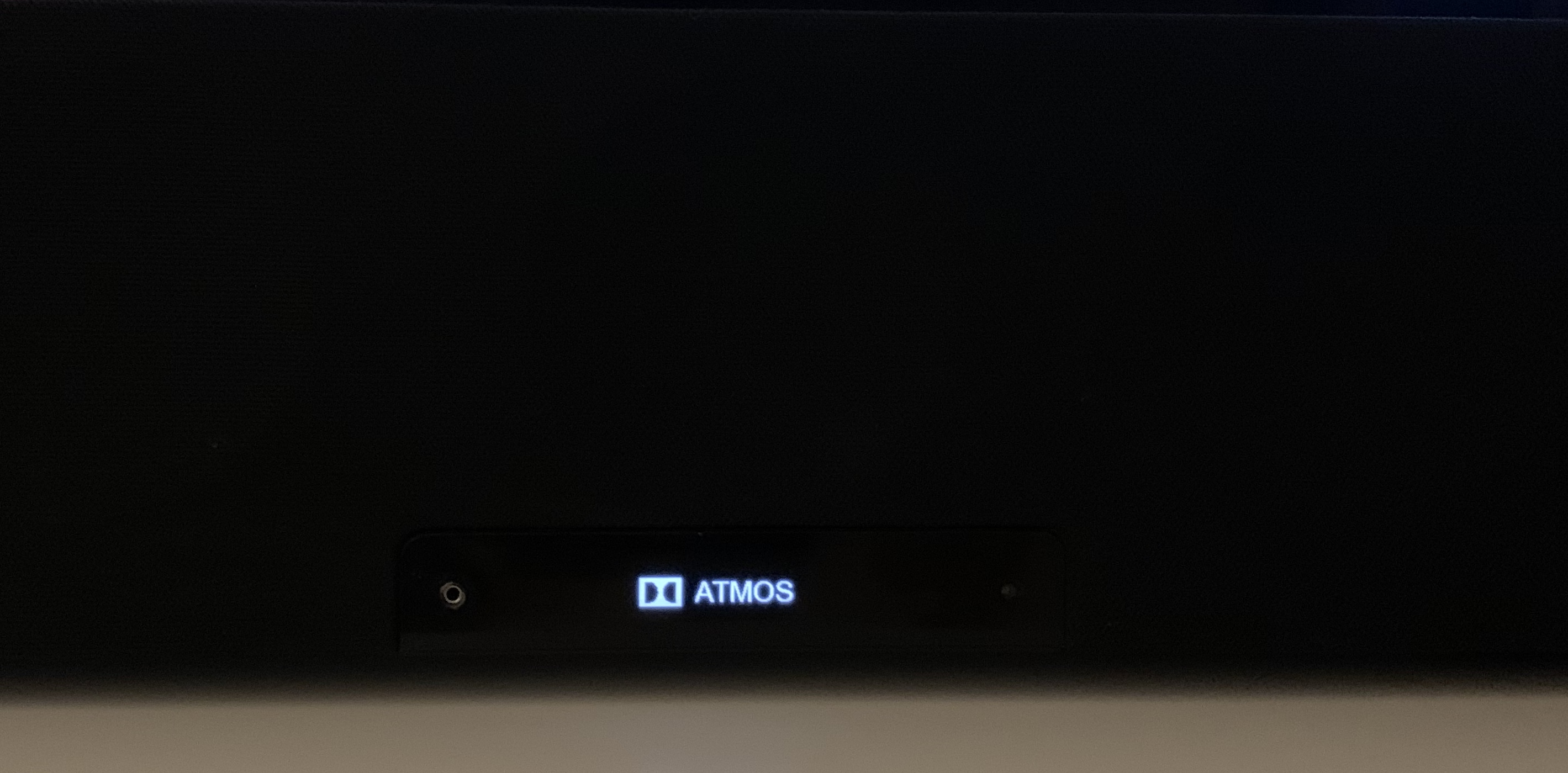
A couple of times, Ambeo lost the audio connection after I paused a movie. However, I have experienced similar issues with other combinations of TVs and soundbars and it occurs to me that it is related to HDMI handshake issues. More alarming though was that the soundbar towards the end of the review period started acting erratically. The front diode would flash and show 'Movie' (to indicate that Movie mode was selected) as if someone has clicked a button on the remote control. It would disappear again after a reset but returned and when it did it forced Apple TV to turn off its 'match content' function and default to HDR, which just added to the frustration.
One of the most important aspects of TV use has to be a soundbar's ability to reproduce clear and accurate voices. So I am happy to conclude that Ambeo delivers. Voices sound clear and balanced, and there is no need to fumble around with settings to enhance the news reader's voice. If you simply want to tone down bass a little bit you can easily switch to 'Normal' mode but in my opinion it is not necessary. Ambeo has balanced bass and does not try to impose extra bass in an unnatural or unpleasant way.
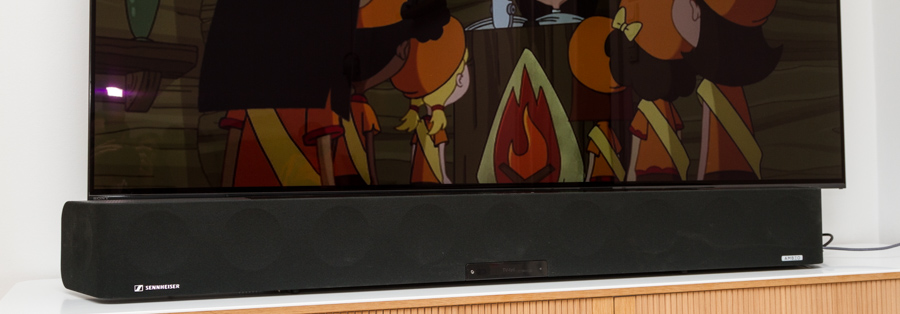
In our region of the world, there are no TV channels broadcasting in any object-based audio format, neither Dolby Atmos nor DTS:X nor MPEG-H - and we assume that it will take years still. We have had MPEG-H, an object-based audio format developed by Frauenhofer, demonstrated on the Sennheiser Ambeo, and seen how it will allow broadcasters to include multiple audio tracks that the user can switch between to change language or audio perspective during, say, a football match; stadion sound, speakers or mixed. MPEG-H will also be able to serve different tracks during concerts, allowing to user to experience the concert from different vantage points. In that sense the potential of object-based audio, where each sound is stored as a separate object, goes far beyond just better movie experiences - and there is potential for manufacturers to sell lots of object-based audio systems to consumers.
For now, we will have to settle for TV broadcasts in Dolby Digital 5.1 in the best case. Ambeo has an upscaling feature that tries to take a conventional audio source and make it more immersive or room-filling. It can be activated from the app under 'Ambeo' settings. I found the effect unconvincing, similar to how many TVs try to upconvert SDR video to HDR, in the sense that you must be prepared to accept something that sounds - or looks - heavily artificial, created by an algorithm. In its neutral setting (the default) Ambeo delivers balanced sound without trying to force the news reader's voice to sound like something pseudo-Atmos mishmash.
As mentioned, I ran into some issues with HDMI while watching movies and the same issues arose at times while watching TV channels. The display flashed momentarily with 'Dolby Digital+' as if a new audio source had been detected, even though nothing had changed. It can be quite frustrating.
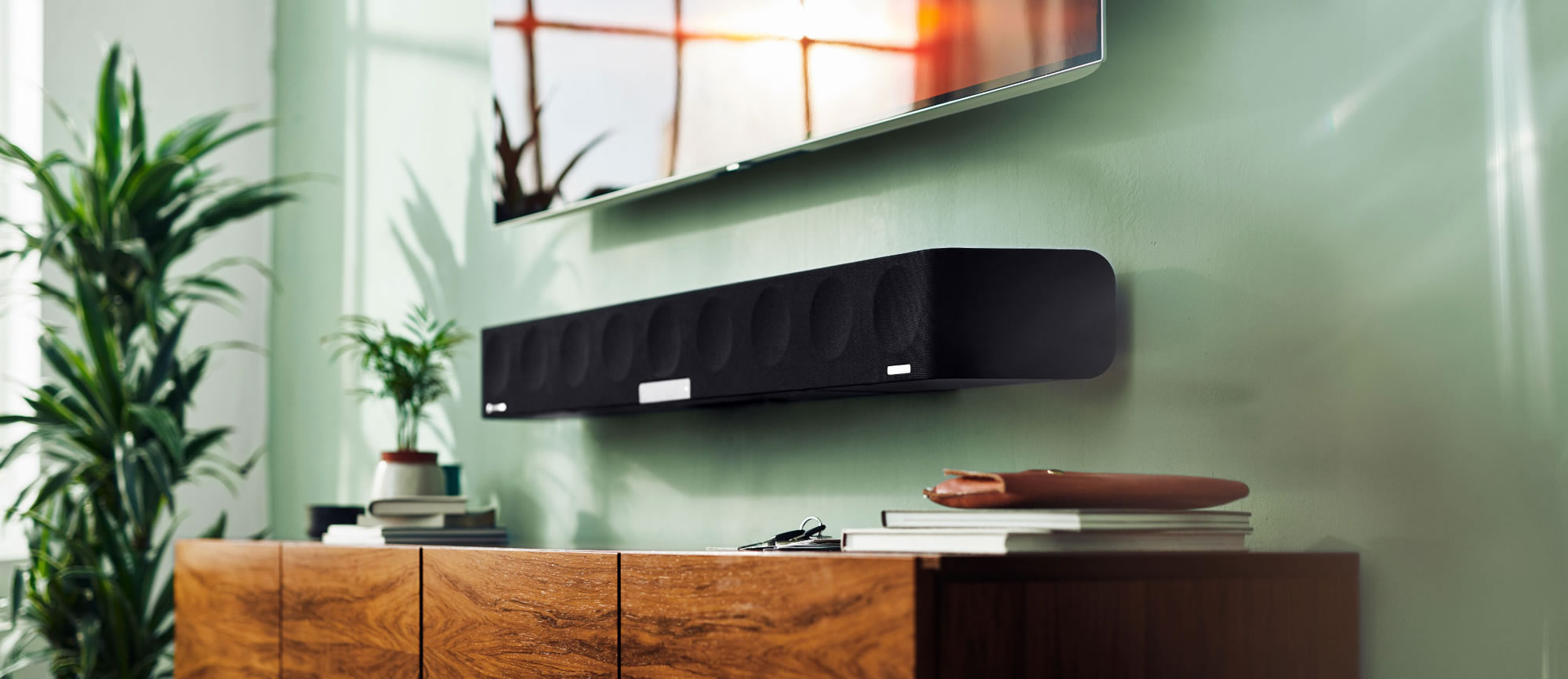
Sound: Music
After having watched and rewatched lots of movies, I turned my attention to Ambeo's musical performance. We have Apple devices at home and in these days where AirPlay 2 technology is becoming a standard feature in new speakers, it is disappointing to find that Sennheiser Ambeo lacks support for this wireless audio protocol. On the other hand it has Chromecast and Bluetooth (4.2) built-in. An alternative route is to use a connected Apple TV, which has multiple music apps as well as AirPlay 2. So I loaded up my usual demo playlist and changed sound preset to 'Music'.
Amongst my playlist tracks is
Bird on a Wire by Jennifer Warnes, which is a track of very high recording quality. Here, I missed the level of separation that true stereo speakers, with distance between units, can deliver. With Ambeo, I was not able to pinpoint the various elements in the song either. Voices on the other hand sound clear and despite a little ringing in the bass, finer details in the track were maintained.
Mary Chapin Carpenter's
Mrs. Hemingway sounded fine with good precision in vocals although Ambeo has a tendency to sound a little challenged at the very high notes, an area where more expensive speakers will outperform Ambeo. This track reveals that mid-tones and treble lose some breadth on Ambeo, but overall Ambeo still delivered pleasant and convincing performance considering that it is a soundbar and not a full music system.
Butterfly by Jason Mraz has a mix of vocal and drums, which is a good match for Ambeo's combination of speaker units. Drums appear with the same precise punch as movie sequences. Continuing the party with
Sing Sang Sung by Big Phat Band we were met by a well-controlled bass and saxophone but Ambeo did not master all of the wind instruments. Still, I was fairly impressed by how it handled this genre and the narrow stereo perspective was not as pronounced here as before.
Switching to a more electronic type of music, Ambeo handled
Undone by Spaces & Sarah de Warren and
Breathe Into Me by Marian Hill well, partly because these tracks are good matches for its many bass units and the compact format, and because a more narrow stereo perspective doesn't affect the music experience to the same degree here. However, it is possible to bring the bass to its knees with tracks such as
Tiger by Paula Cole or
Take The Power Back by Rage Against The Machine. Here, a dedicated subwoofer would help lift the music experience.
This is a soundbar, with all of the implications that follow, so it is always an ungrateful exercise to evaluate musical performance. You can buy a receiver and stereo speakers that outperform any Atmos soundbar in musical performance for less - and get that wide stereo perspective that music deserves. On the other hand, many listeners today turn to small streaming speakers in the living room and compared to these solutions Ambeo will deliver far more harmonious sound, while at the same time serving as a powerful TV speaker. It simply has much better hardware and units than you will find in streaming speakers and other soundbars. So if you are looking for solution for TV audio that doubles as a compact music system Ambeo will deliver overall good sound for the living room, with enough volume and punch to fill the room. Amongst soundbars it is product from the top shelf.
Conclusion
There are few competing soundbar solutions in this price class ($2499 / €2499) so the question becomes; is Ambeo worth its high price tag? Of course, the answer to that question will depend on a number of objective and personal factors. Our answer would be "yes and no".
Ad:
Ambeo represents the best audio experience that you can get from a soundbar right now. It delivers heavy and tight bass, without a subwoofer, for impactful explosions and action sequences combined with overall balanced sound, including great voice clarity. Unlike many other soundbars, bass does not turn muddy and treble not squealing. In other words, Ambeo clears the hurdles often associated with soundbars.
But Ambeo is, of course, not a conventional soundbar. It promises to deliver an encompassing 3D audio experience through Dolby Atmos, DTS:X and MPEG-H. And while it manages to take advantage of object-based audio to place sounds quite accurately in front of the listening position, and to some degree above, it never really reaches behind the listener. Here, soundbars with dedicated rear speakers - and extra up-firing channels - have an advantage. Perhaps Ambeo is best described as a more capable big brother to
Sony ST5000 - our previous favorite soundbar without rear speakers - than a full-blown Dolby Atmos system that can deliver an all-encompassing audio experience. Samsung's
HW-N950, for example, delivers a more immersive sound stage.
If you want a single speaker solution with some Atmos capabilities for your living room, you should definitely consider and experience Sennheiser's Ambeo soundbar, preferably next to a couple of cheaper soundbars to discover how its better speaker hardware and balanced sound significantly lifts the audio experience. Ambeo is perhaps the most complete package for the living room but not necessarily the best Atmos solution. In the end, we think you need to determine for yourself to what extent you value the full surround experience over the superb sound that Ambeo delivers on all other fronts.
Price and retailers:
Overall impressive sound
Fills up the room - in front of listener
Good music system too
Dolby Atmos, DTS:X & MPEG-H support
3 HDMI (Dolby Vision passthrough), HDMI eARC
Build quality
Atmos rear effects
Physical dimensions
No AirPlay 2
Nearest competitors

